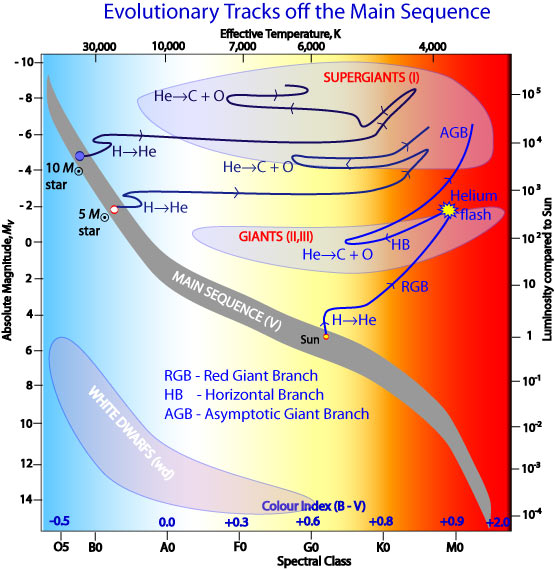|
|
 Evolutionary paths on the Hertzsprung-Russell diagram, from The Australia Telescope Outreach and Education site. RGB stands for Red Giant Branch, HB for Horizontal Branch, and AGB for Asymptotic Giant Branch (which is the formal name for the second ascent of the red giant branch, when helium is being fused in a shell around a carbon core). Note that the times covered by these tracks are very different: the 10-solar-mass star would complete its evolution and die (probably in a supernova) long before the Sun or the 5-solar-mass star left the main sequence.
Evolutionary paths on the Hertzsprung-Russell diagram, from The Australia Telescope Outreach and Education site. RGB stands for Red Giant Branch, HB for Horizontal Branch, and AGB for Asymptotic Giant Branch (which is the formal name for the second ascent of the red giant branch, when helium is being fused in a shell around a carbon core). Note that the times covered by these tracks are very different: the 10-solar-mass star would complete its evolution and die (probably in a supernova) long before the Sun or the 5-solar-mass star left the main sequence.
|
Summary of Lecture 4 – The Lives of Stars
-
Stars require a central energy source to maintain the outward pressure that prevents them from collapsing under their own gravity:
- pressure in stars is higher at greater depths because both the density and the temperature of the stellar material increase as you go down;
- as stars are constantly radiating energy, their temperatures can only be maintained if this energy is replenished;
- the energy is generated in the centre, where the temperature is greatest, and conveyed to the surface by radiation (absorption and re-emission of photons) or convection (hot material rising and cool material falling).
- Stars generate energy by nuclear fusion (combining two light nuclei to make one heavier one):
- this generates energy up to iron; fusing nuclei heavier than iron requires energy;
- energy is generated by converting mass to energy:
E = mc2;
- the most efficient fusion reaction, converting 0.7% of the initial mass to energy, is the conversion of hydrogen-1 to helium-4.
- Main sequence stars fuse hydrogen to helium in their central cores
- either directly via the pp chain
- or using carbon as a catalyst (CNO cycle).
- When hydrogen runs out in the core, the star will start fusing the hydrogen that lies in the layers just outside:
- the readjustment of pressure causes the star to expand into a red giant;
- the pure helium core is not hot enough to start fusion at this stage.
- During its red giant lifetime the star gets cooler, but larger and more luminous (bigger effect for less massive stars):
- this creates the red giant branch on the HR diagram;
- mass may be lost from the outer layers of the star, because it is so large that its surface gravity is small (remember gravity is an inverse square law: if you are twice as far from the centre, the gravitational force is four times weaker);
- as the continuing fusion enlarges and heats the helium core, eventually it will become hot enough to fuse into carbon.
[Note that the red giant does not "run out of hydrogen" – there is plenty of hydrogen left in its outer layers when helium fusion ignites.]
- Helium fusion follows the same stages:
- first in core, producing relatively small, hot star on the horizontal branch of the HR diagram;
- (the star's position on the horizontal branch depends on its mass, but also on its heavy element content – stars low in heavy elements are located further to the left (blue) on the HB)
- then in layer just outside (carbon) core, producing large, cool red giant (actually on the asymptotic giant branch, see diagram above) which is noticeably unstable and will lose mass;
- as helium fusion is less efficient, helium stages last for a much shorter time than the equivalent hydrogen stages.
- Helium fusion produces mainly carbon, but also some oxygen and a few free neutrons:
- adding neutrons to nuclei is easy because they have no electric charge (so no repulsion from positively charged nucleus);
- this process produces many elements which are not directly generated by fusion.
Production of heavy elements by adding neutrons inside helium-burning stars is called the s-process, because it takes place very slowly (s = slow).
Web links
- The PowerPoint file for this lecture.
- More detailed notes on
stellar evolution.
- Stellar evolution is covered in Gene Smith's Astronomy Tutorial and Nick Strobel's notes. Both start with star formation, which we will come to in lecture 6.
- Another good account of stellar evolution, with some excellent diagrams, is The Australia Telescope Outreach and Education site. This is at a slightly higher level than this course.
- I got the stellar evolution data from a Geneva University catalogue in this database, which has copies of more astronomical data files than you (or anyone else) will ever want (the nearby star data also came from this database). For experts only, I think. The atomic masses used to construct the graph of atomic mass per nucleon came from Kenneth Krane's book "Introductory Nuclear Physics" (John Wiley).
- A short self test for this lecture.
Go back to main page
Go on to Summary for Lecture 5
|
Hicks Building, Hounsfield Road, Sheffield S3 7RH, UK
|